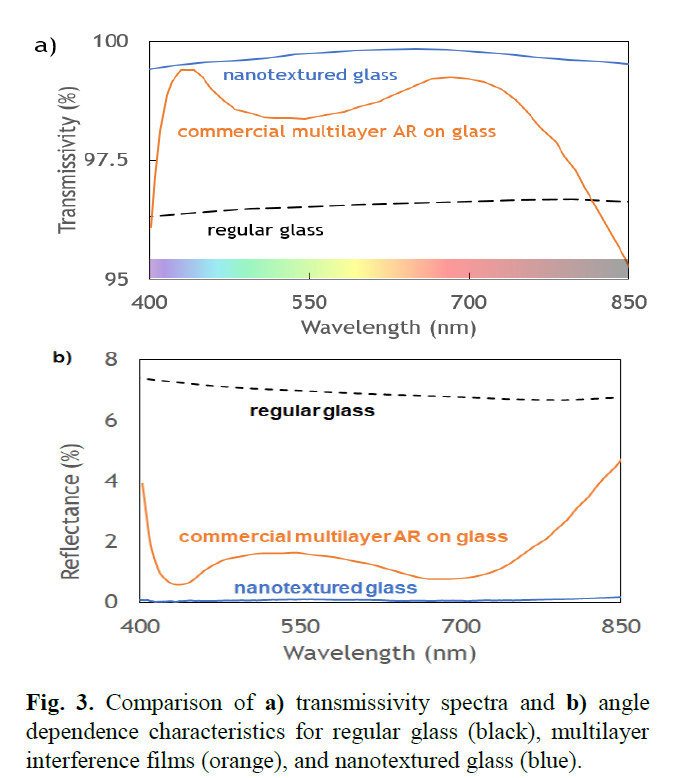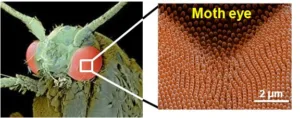Edgehog is a Montreal-based start-up that has developed a better mousetrap – i.e. a better anti-reflection technology that is robust and offers low reflectance over wide viewing angles and over the full visible spectrum. Their claims intrigued us, so we had a nice conversation with co-founder Calvin Cheng and Business Development Manager, Kris Manipon.

As most readers know, anti-reflection on displays is typically accomplished with thin film coatings designed to create destructive interference. But, to cover the full visible spectrum requires lots of coating layers, with over 100 layers not uncommon for high-performance films, leading to high cost. The fewer the layers, the more non-uniform the anti-reflection performance over the visible spectrum.
But there is another problem – off angle performance. All these layers are design for on-axis viewing, but as the angle of viewing increases the optical path lengths change and so does performance. This can not only lead to decreased anti-reflection values off axis, but color shifts as well. Plus, they can delaminate with extreme temperature cycles.
An elegant solution to this dilemma has been the moth eye structure developed by multiple companies over the last five years or so. Moth’s eyes are really good at reducing reflections so they can see well at night, which is why manufactures wanted to replicate their structure, which consists of an array of nanometer-scale cone-like structures.
Unfortunately, none of the techniques used to fabricate moth eye structure have not been robust or scalable enough to reach mass production. This is where Edgehog’s better mousetrap comes in. Their technology, features a plasma etch of a glass substrate, thus solving the robustness and scalability challenge.
According to Cheng, they can plasma etch the entire substrate rather than using the e-bean scanning techniques of previous moth eye manufacturing methods. This makes it quite scalable for smaller sized displays, as many display assemblers have plasma etch machines that can be used for the Edgehog process. The idea is to simply etch the coverglass to create the structures.
Cheng said that they have developed the process-fused silica, but they are also working now to perfect it on Gorilla glass, a common cover glass material. “We can do the nano-etching process before or after the ion-exchange treatment used to create the hardened Gorilla glass,” said Cheng.
So how do they create their nanostructures, we asked? Cheng explained:
“It is a two-step process. First, we apply a thinfilm polymer to the glass that is induced to self-align into the nanometer-scale pattern. The second step is the plasma etch that can create structures with around 10 nm resolution to create the nanotextured glass.”
The image below shows a comparison of regular (left) and nanotextured glass (right) illuminated by ambient lighting showing greatly reduced reflectance from the nanotextured sample. In b) is a cross-sectional view of the nanotextured surface with 200-nm-tall cones

Optically, these cones created a graded index from air (n=1) to glass (n=1.5). This is what creates the strong performance characteristics.
As for performance, the number are impressive. Transmission is 99.8% and reflectivity less than 0.1% over the entire visible spectrum. And, the nanotextured glass materials that Edgehog can produce offer much better angular performance as well. For example, transmissivity of multilayer AR films on glass start to roll of at 30 degrees while the nanostructured glass doesn’t start to roll off until 50 degrees and is much higher at 75 degrees.

Is the nanostructured surface robust enough for normal wear and tear, we asked? They think so. For example, there is no danger of delamination and they have tested it under high density light sources showing it is actually more robust than ordinary glass. Yes, it will be susceptible to scratches, but if the base material is Gorilla Glass or some other chemically-strengthened material, the underlying properties will remain the same as far as scratch and breakage resistance.
As for the company’s business model, Cheng says they want to license the technology to glass makers as well display builders with a focus more on small displays to begin with. The license would apparently include a license to the polymer self-aligning film along with all the process knowhow to make these nanostructured glass substrates.
Oh, and the technology can be useful beyond displays too. For one, the nanostructured glass is superhydrophobic which means water will quickly roll off the surface. This makes it great for outdoor applications like solar panels or signage displays, but that will require large area processing first. Other applications the company sees include lenses, high power lasers, automotive windshields and displays, architectural glass and more.
This certainly looks like technology worth further investigation. – CC

